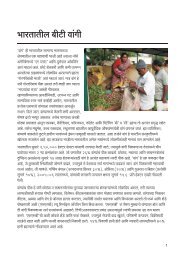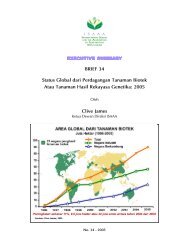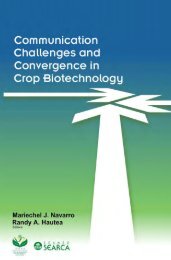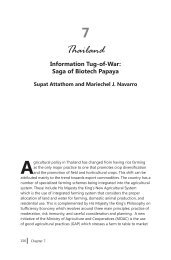Strategizing Communication in Commercialization of Biotech ... - isaaa
Strategizing Communication in Commercialization of Biotech ... - isaaa
Strategizing Communication in Commercialization of Biotech ... - isaaa
Create successful ePaper yourself
Turn your PDF publications into a flip-book with our unique Google optimized e-Paper software.
Khondoker M. Nasirudd<strong>in</strong><br />
liv<strong>in</strong>g organisms or by import <strong>of</strong> any such materials. These rules will cover the<br />
biosafety <strong>of</strong> transgenic materials produced <strong>in</strong> the country or those that come<br />
through transboundary movement (Rahman, 1990).<br />
awareness, Perception, and adoption Strategy<br />
<strong>of</strong> gM or <strong>Biotech</strong> Crops<br />
Awareness and extent <strong>of</strong> knowledge on genetic eng<strong>in</strong>eer<strong>in</strong>g, biotechnology,<br />
and GMOs among the people are relatively low. Bangladesh’s National<br />
Biosafety Framework (2006) forwards the need to promote and facilitate<br />
public awareness, education, and participation concern<strong>in</strong>g the “safe transfer,<br />
handl<strong>in</strong>g, and use <strong>of</strong> GMOs <strong>in</strong> relation to the conservation and susta<strong>in</strong>able<br />
use <strong>of</strong> biological diversity and risks concerned with human health.” It also<br />
adds that the public should be consulted regard<strong>in</strong>g decisions about GMOs<br />
and biosafety so that the regulatory system is perceived to be transparent<br />
and that public acceptance may enhance biotechnological development <strong>in</strong><br />
the country.<br />
In 2003, the Bangladesh Rural Advancement Committee (BRAC) conducted a<br />
survey <strong>of</strong> the knowledge, attitude, and perception <strong>of</strong> civil society groups on<br />
rice biotechnology research <strong>in</strong> the country not<strong>in</strong>g that these groups mold<br />
public op<strong>in</strong>ion on various national issues. Earlier, IRRI conducted focus group<br />
discussions to pilot test the survey questionnaire. Respondents <strong>of</strong> the BRAC<br />
survey were classified <strong>in</strong>to three groups: 1) scientists and research leaders<br />
<strong>of</strong> agricultural research and educational <strong>in</strong>stitutions who are expected to be<br />
more knowledgeable about the potential risks and benefits <strong>of</strong> biotechnology<br />
and may be its proponents; 2) managers and senior executives <strong>of</strong> NGOs and<br />
environmental advocacy associations who might have been <strong>in</strong>fluenced by the<br />
on-go<strong>in</strong>g debate <strong>in</strong> the developed countries, and may be the opponents <strong>of</strong><br />
biotechnology; and 3) other civil society groups who may be least exposed<br />
to the debate and may hold a neutral position. N<strong>in</strong>ety-n<strong>in</strong>e percent <strong>of</strong> the<br />
232 respondents reported to have heard about biotechnology while 59% said<br />
they heard about GMOs. About 86% correctly def<strong>in</strong>ed “GMO” as genetically<br />
modified organism.<br />
210<br />
Chapter 9








